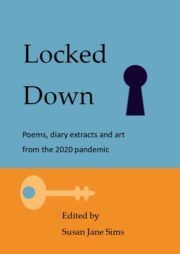Lizzie Ballagher reviews two Poetry Space .best sellers: What the Trees Are Telling Me by Elizabeth Rapp and Chester City Walls by Julia D. McGuinness
Both of these titles are in their second print run. Congratulations to Elizabeth and to Julia.
Elizabeth Rapp: What the Trees Are Telling Me
What the Trees Are Telling Me is a collection to be read slowly and savoured. Admittedly, another review is probably superfluous; comments by Penelope Shuttle, John Latham (and others) which already appear on the jacket sum up much of what assuredly deserves to be said. Even so, enjoying Elizabeth Rapp’s poetry as much as I did, I wanted to add praise too.
Perhaps because of her religious beliefs, and also perhaps because of her experiences, Rapp’s vision is shot through with a sense of life’s tender brevity:
“all these I hold in a fistful of grit,
Let it trickle slowly through my hands.”
Still, while a poet like Thomas Hardy saw and described beauty and joy on a collision course with ironic, bitter destruction, Rapp, more like the poet Gerard Manley Hopkins, sees life’s “suddenness”, instead, as a cause for sharp observation and celebration:
“hedgehogs and kittens kneading her milky belly,
eager tiny mouths, suckling life.”
In this collection, Rapp never allows the many things she describes to rest in the predictable stasis of nouns and adjectives; her feelings, too, are conveyed brilliantly, imagery and emotion underpinned by verbs chosen with such pinpoint precision that everything acquires a marvellous and immediate physicality:
“white spears of grass stab the air”
“I drift to the quiet blur of the pond
where I slip into the lily’s white heart.”
I was impressed, as well, by the poems’ daring originality. In “Fibonacci Poem in Reverse”, for example, Rapp boldly applies (the Italian mathematician) Fibonacci’s number sequence to her cleverly arranged lines about the passage of time.
This book is an absolute delight. Thank you, Elizabeth, and thank you, Poetry Space, for poems I shall read again and again.
Lizzie Ballagher
Chester City Walls: A Poet’s Mosaic by Julia D McGuinness
Poetry Space, Ltd, 76pp
I wasn’t sure what to expect from this collection of poems. It’s decades since I’ve been to Chester; and I wasn’t at first convinced that I wanted to “commit” to reading an entire book about one place. But Julia’s poems offer so much more. Chester City Walls encourages readers to look down the telescope of time at what it means to create a certain space, to inhabit a community fit for purpose in its own time. The result is a satisfying, thoughtful read with Chester as a sort of Tardis that whizzes between the Roman founders, the Viking invaders, the English Civil War, and the present day. Yes, here is another absorbing read from Poetry Space.
This book with its colourful sketch-maps deserves to be read in quite an unusual way. The subtitle gives away the poet’s intention: each poem is like a mosaic tile (or even a carved block of wall-stone) that builds to a complex picture of the city—and more: also of the people that time throws into the city walls’ embrace: Romans, monks, a Saxon queen, students, Brunel, Halley of comet fame…to name but a few.
Jostling elbows with residents and visitors, Time itself is the key inhabitant of Julia’s Chester. “The human river flows,” Julia tells us, describing the endless throng of people along and below the walls: from Roman soldiers to modern tourists who “continue the footfall / unawares; / tread on ghosts” (“Perpetuum Mobile”).
She presents us with touching snippets of dialogue, for example between herself and students who have arrived from overseas (“Snapshot”); with deft, colloquial detail of some of the more curious denizens of the city: “No nuns along Nuns Road…just a bunch of suits drinking outside the Architect”; and with poignant detail:
“See here by the Watergate,
how clusters of purple stars foam
and feather the sandstone face…
Ripped from their holding, tossed onto paving,
discarded blooms lie like limp bodies
that fell—or jumped—from the City Wall.”
I also enjoyed the variety of structures this poet was willing to employ. Just as Chester’s walls consist of different corners, niches, towers, bridges, arches, etc, so Julia experiments with forms such as a villanelle (“The Wishing Steps”), sonnet (“Sonnet of the South East Aspect”), a list poem (“The Wisdom of the Water Tower”)—free verse and rhyming poetry intermingling comfortably. “On Reading the Murengers’ Rolls of 1441” is a tour de force, with two 15-line stanzas readable from top to bottom or bottom to top, appropriately, like the scrolls themselves.
And thank you, Julia, by the way, for teaching us that wonderful word “murenger”!
Lizzie Ballagher, February 2017







